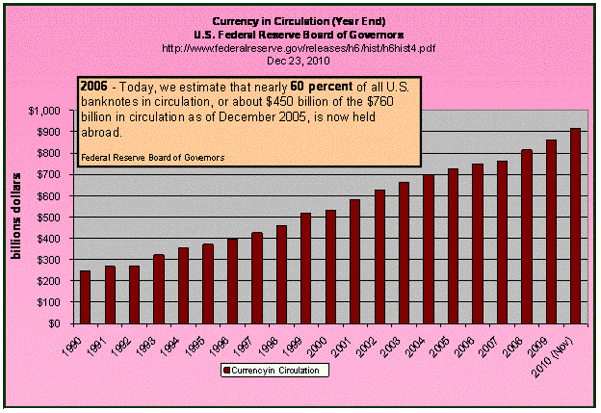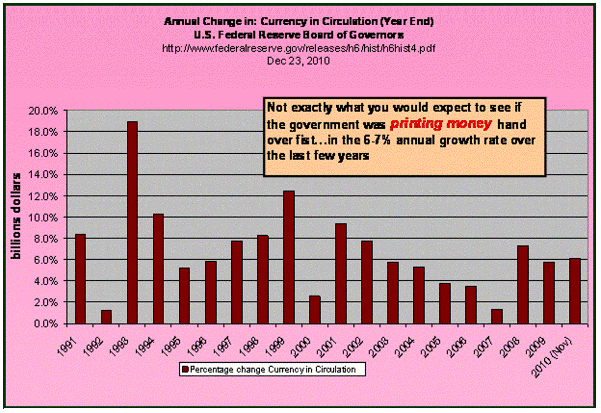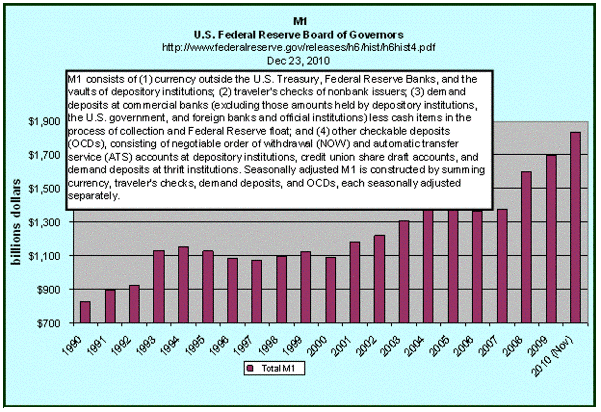January 6, 2011
For a downloadable version, click the following:
The Great Printing Press Myth (Great Pumpkin) has descended upon the land: Government is printing MONEY; hyper-inflation is imminent; and all of those excess dollars will have to be burned, resulting in an environmental disaster of epic proportions
Note/caution/caveat: we are not, repeat, not condoning or endorsing the continued enormous growth of the federal budget deficit and resultant expansion of the nation’s debt.
Charlie Brown, where are you?
All forms of media, including cyberspace, are echoing at ear drum bursting decibel levels (typical sound of a teenager’s mp3 at three-quarters volume and higher), of what is becoming one of the great myths of all time. This short blog can just alert you to it and apprise you of more extensive treatments of the topic at issue.
The myth is that the gigantic federal budgetary deficits, and they are indeed gigantic for peace time, are being financed by printing paper money at such a fast rate that significant inflation in the very near future is certain to occur. If this inflation is truly at hand, the government must then find a way to take all the paper money back and burn it in a great bonfire, à la Charlie Brown, if we can find him, in order to stop the inflation. If so, it will cause an environmental disaster of catastrophic proportions. Even Lucy, Snoopy, Woodstock, Linus, Schroeder, with the help of Peppermint Patty, will not be able to stop it.
To argue that the ‘growth of money’ causes inflation, is a theory that in past times was relevant in that it explained economic reality in a reasonably correct manner. In recent years, especially since the great inflationary period of roughly the 1970s, that theory has lost much of its relevancy as a basis for prediction and guiding monetary policy.
The proponents of this myth do not really understand the causes of inflation nor do they have a clear understanding of what comprises ‘money’ in their theory that will cause inflation when it grows at too fast a rate.
The printing presses referred to are at the United States Bureau of Engraving and Printing, a division of the U.S. Treasury www.moneyfactory.gov/home.html . Currently, nearly all of the paper money circulating consists of Federal Reserve Notes, non-redeemable, non-interest bearing liabilities of the Federal Reserve System, the central bank of the United States of America.


Today, we estimate that nearly 60 percent of all U.S. banknotes in circulation, or about $450 billion of the $760 billion in circulation as of December 2005, is now held abroad.
Joint Report: The Department of the Treasury; Board of Governors of the Federal Reserve System; United States Secret Service
September 2006
www.federalreserve.gov/paymentsystems/coin_about.htm
Much of that paper money, nearly 60% of it, is held by people outside of the U. S. in nations where its citizens have more faith in the U. S. paper money maintaining its purchasing power than will the paper money issued by the nations in which they live.
www.federalreserve.gov/boarddocs/RptCongress/counterfeit
Most of the remaining paper money facilitates all of the transactions of the ILLEGITIMATE economic activity in the U.S., the so called “UNDERGROUND ECONOMY”, consisting of indictable activities including tax, child support and alimony evasive activities.
Monetarism is the theory that is used to argue that a rapid and persistent growth in money will lead to inflation. Monetarism is a descendant of the old Quantity Theory of Money which was formalized in the 1700s but has even earlier precedents. But paper money (nearly all of which currently circulating in the U.S. and elsewhere, consists of Federal Reserve Notes) is part of currency, which in turn is part of what is termed M-1 money and the other broader monetary aggregates such as M-2 money. Currency is equal to the sum of this paper money plus the metallic coins issued by the Treasury.

Money has two meanings. In its most narrow definition, it is the medium of exchange, or those things which are generally acceptable as a medium of exchange. Money in this role is called M-1 money. Another meaning of money is that it is a liquid store of wealth. M-1 is the most liquid store of wealth and it is also the medium of exchange. It consists of currency, checkable deposits, and a relatively minuscule amount of non-bank traveler checks. The Federal Reserve Board of Governors does the defining.
M-2 is another monetary aggregate, to which measures of money are referred. It includes M-1 and a non-M-1 component consisting of small time deposits (under $100,000), individually owned money market mutual fund shares, overnight and continuing contract Federal Funds loans, and overnight Eurodollar deposits.

Until a few years ago, the Fed defined, estimated, and reported even broader measures of money: M-3, M-4, and M-5. They claim they no longer estimate them and they obviously do not publicly report them even though they still exist in reality.
Monetarists argue that it is the broader aggregates such as M-2 or M-3 and NOT just paper money whose behavior can cause inflation. Estimates of the components of money [however defined] that facilitate the legitimate economic activities of the U. S. economy have been made over the years. A reasonable average of these estimates is that 90% of the legitimate transactions of the U. S. economy are facilitated by checkable deposits, NOT paper money.
Checkable deposits [money] are liabilities of the private sector depository institutions, NOT the federal government. The depository institutions which are mostly for-profit include the commercial banks, savings banks, credit unions and the few savings and loan associations that survived their great collapse in the 1970s and early 1980s causing the bankruptcy and disappearance of the Federal Savings and Loan Insurance Corporation (FSLIC), a wholly owned U.S. government insurance agency. Déjà Vu!!!!!
Most of the checkable deposits [money] are created by the private sector depository institutions in the process of their creating credit. Yes, the financial institutions, i.e., banks create checkable deposits liabilities, Virginia! In that process of creating credit, they bestow ownership of newly issued checkable deposits to those obtaining credit from such depositories. Such credit creation activities of depository institutions that result in the creation of checkable deposit-money are shown as loans and investments on the balance sheets of these depository institutions.
Unfortunately, most of the so-called experts appearing on the media do not understand this and add to the number of promoters of this great myth. A few use the term, “running the printing presses” and refer to the government “printing money” are using metaphorical license due to the need to answer complicated questions in 30-second sound bites. When it comes to the media (and academia), it is often a case of the blind leading the blind, passing off misleading analysis as economic and financial gospels.
Speaking of analysis…
For a more thorough analysis, not limited by 30 second bites or the brevity of blogs such as this, please refer to our past articles and stay tuned for more thorough explanations to follow.
December 31, 2003
(The Federal Reserve System: Sausage making and its relation to monetary policy)
www.econnewsletter.com/blog/dec312003
Archives Economics Blog December 2003
July 21, 2009
Will the Fed’s actions be inflationary?


